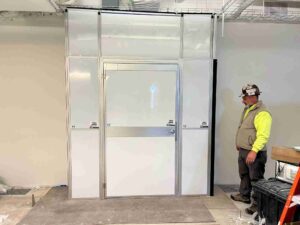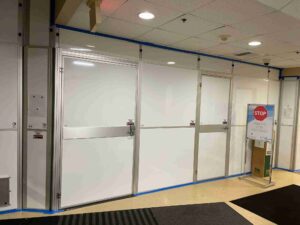What is a Dust Barrier System?
Tackling dust on construction sites starts with a simple yet powerful strategy: containment. Whether you’re working on a large-scale project or a small renovation, utilizing plastic sheeting, tarps, or temporary walls to work as a dust barrier system effectively separates the construction zone from the rest of the space.
This article explores the importance of dust containment in construction, emphasizing the proactive measures needed to keep workers and surrounding areas safe. By understanding the benefits behind containment, you can make informed decisions about which dust barrier system suits your project best.
What is a Dust Barrier System?
A dust barrier system is any structure that is designed to keep dust contained. What these temporary walls do is keep dust out of a room during construction, shield surfaces, and ensure proper air quality. It can be composed of protective films and plastic sheeting or it can be walls constructed with air filters.
What are the Benefits of Using a Dust Barrier System?
Discovering the benefits of using a dust barrier system is crucial when dealing with dust in construction, remodeling, or restoration. Whether handling delicate equipment in a medical facility or protecting customers and employees during a retail remodel, understanding the advantages of a dust barrier system is essential for a seamless and efficient project experience.
Below we explore the benefits to a dust barrier system that result in keeping dust contained:
- Ensuring safety and preventing injuries: A dust barrier system plays a crucial role in maintaining a safe working environment by containing dust, reducing the risk of respiratory issues, and preventing accidents related to poor visibility and slippery surfaces.
- Extending the lifespan of equipment: By minimizing dust exposure, a well-implemented dust barrier system helps prevent equipment wear and tear, corrosion, and damage, ultimately contributing to the longevity and efficiency of machinery and tools. Dust barrier systems in the form of modular containment rooms are also great for data center containment.
- Meeting dust compliance standards: Employing a dust barrier system ensures adherence to industry and environmental regulations, avoiding fines and legal consequences while promoting responsible and compliant construction practices.
- Offering improved indoor air quality: Dust containment enhances indoor air quality, creating a healthier workplace environment for workers and reducing the potential for respiratory problems, allergies, and other health issues associated with airborne particles.
- Boosting production efficiency: A dust-free environment contributes to smoother operations, minimizing downtime caused by equipment malfunctions, cleanup delays, or health-related absences, thereby enhancing overall production efficiency. Making a construction project manager’s life a lot easier.
- Warding off contamination: Dust containment prevents cross-contamination between different work areas, safeguarding materials, products, and equipment from potential pollution, ensuring the integrity and quality of the work being performed.
- Sustaining an excellent safety record: Implementing an effective dust barrier system is a proactive step toward maintaining a stellar safety record, fostering a positive workplace culture, and attracting clients who prioritize safety and quality in construction projects.
What Industries Can Benefit from a Dust Barrier System?
Dust barrier systems, whether in industrial or smaller-scale setups, should comply with government regulations, as these systems contribute significantly to safety, comfort, and operational efficiency in different industries. They provide essential protection for workers, shareholders, and management across various trades and businesses, such as the following:
- Medical: In healthcare settings, dust barrier systems maintain sterile environments crucial for patient safety and compliance with healthcare regulations.
- Construction: Construction sites benefit from dust barriers by enhancing worker safety, preventing contamination, and promoting compliance with environmental regulations.
- Laboratories: Laboratories utilize dust barrier systems to preserve the integrity of experiments, protect sensitive equipment, and ensure a controlled and contamination-free environment.
- Schools: Educational institutions use modular walls for a number of reasons, including dust barriers to create clean and safe learning environments, supporting the health and well-being of students and staff.
- Pharmaceuticals: Dust containment is vital in pharmaceutical facilities to maintain the purity of drugs, prevent cross-contamination, and adhere to strict quality control standards.
- Warehouses: Warehouses benefit from dust barrier systems to safeguard stored goods, maintain a clean working environment, and comply with safety regulations.
- Retail: Retail spaces use dust barriers to enhance customer experience, protect merchandise, and uphold a clean and appealing shopping environment.
- Manufacturing: In manufacturing settings, dust barrier systems contribute to worker safety, protect machinery, and ensure product quality by preventing dust contamination.
How Do You Make a Dust Barrier?
In a remodel or renovation, dust can be frustrating. Good dust control is crucial for success and needs thorough preparation before starting. Here, we’ve outlined steps on how to implement ten steps for you to make an effective dust control barrier.
Step 1: Budget for dust containment in any project to make sure it’s not added as an additional cost to the client later.
Step 2: Seal off the remodeling area with your preferred dust barrier system, we recommend using Temporary Wall Systems modular dust barrier walls.
Step 3: Strategize demolition, starting from the outer areas and working inward, maintaining a permanent barrier.
Step 4: Utilize windows for material removal and to create positive pressure, enhancing air circulation.
Step 5: Cover and seal heat and A/C vents to prevent dust circulation through air ducts.
Step 6: Establish single entry/exit points, limiting access to one doorway and using dust containment door kits.
Step 7: Protect floors inside and outside the project area using protective coverings to prevent dust infiltration.
Step 8: Wear boots with shoe guards to prevent damage to coverings.
Step 9: Cut materials outside, especially drywall, to minimize dust generation during the project.
Step 10: Keep a vacuum handy and clean up dust as you go.
Choosing the Right Dust Barrier Temporary Wall System for Your Project
At Temporary Wall Systems (TWS), we commit to offering containment solutions that prioritize safety, cleanliness, and environmental responsibility while ensuring durability for demanding day-to-day operations. With a deep understanding of the requirements and obstacles in active construction or renovation sites, we provide the market’s top-quality walls.
TWS simplifies the process for you and your team at every stage, offering full-service rentals tailored to your specific project needs—from installation to removal, for projects of any size. Get a free consultation and a quote from us now.


